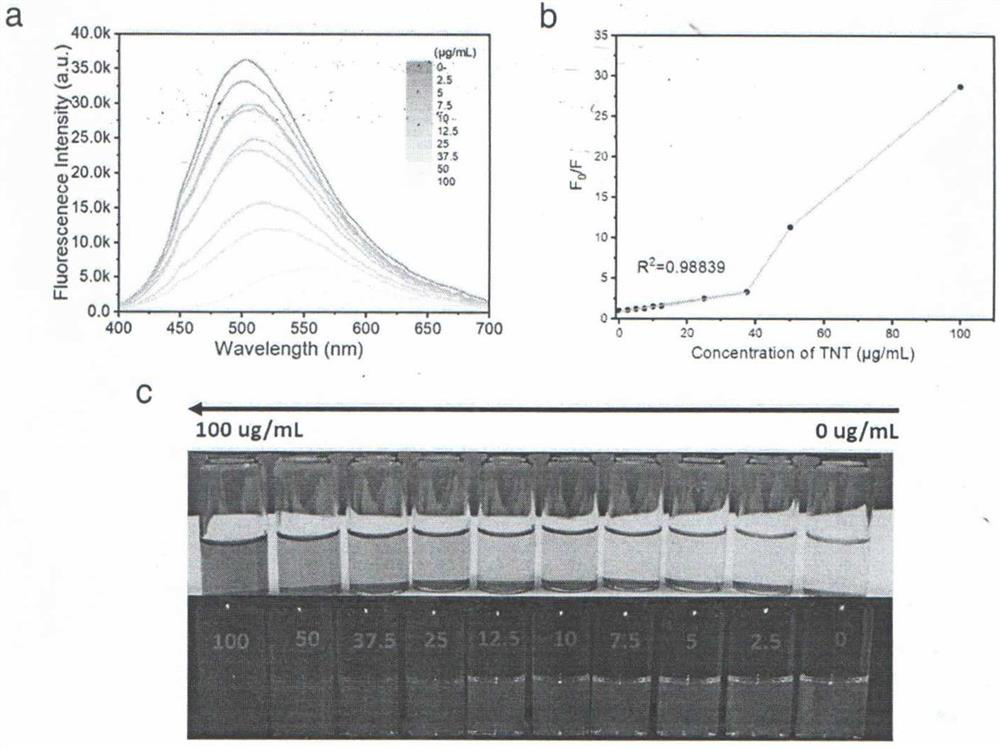Dual-mode fluorescent copper nanocluster for rapid fluorescence detection of trinitrotoluene or trinitrophenol
A technology of fluorescent copper nanoclusters and trinitrotoluene, applied in fluorescence/phosphorescence, measuring devices, and material analysis through optical means, can solve the complex synthesis steps and post-processing of organic fluorescent probes, which do not meet the requirements of on-site detection, At the same time, problems such as difficult detection are achieved to achieve the effect of abundant copper source, easy access to copper source and low price
- Summary
- Abstract
- Description
- Claims
- Application Information
AI Technical Summary
Problems solved by technology
Method used
Image
Examples
Embodiment 1
[0032] a. At room temperature, dissolve 100 mg of branched polyethyleneimine (PEI) Mw=3500 in 4 mL of ultrapure water, and stir uniformly for 10 min;
[0033] b. Add 200 μL of copper sulfate with a concentration of 100 mM and 1 mL of ascorbic acid with a concentration of 500 mM into the branched polyethyleneimine solution in step a, stir evenly, and react at a temperature of 40 °C for 2 hours, the final solution turns light green and appears under an ultraviolet lamp Bright green fluorescence was obtained, indicating that dual-mode fluorescent copper nanoclusters PEI-Cu NCs were obtained;
[0034]c. Put 200 μL of the dual-mode fluorescent copper nanoclusters obtained in step b into a quartz cuvette container, then add 1M NaOH to adjust the pH to 10.0, add 200 μL of trinitrotoluene methanol solution, and use a fluorescence spectrometer after 15 minutes. Scan the fluorescence spectra before and after TNT addition, such as figure 1 As shown in the figure, it can be seen that aft...
Embodiment 2
[0036] a. At room temperature, dissolve 100 mg of branched polyethyleneimine (PEI) Mw=3500 in 4 mL of ultrapure water, and stir uniformly for 10 min;
[0037] b. Add 200 μL of copper sulfate with a concentration of 150 mM and 1 mL of ascorbic acid with a concentration of 600 mM into the branched polyethyleneimine solution in step a, stir evenly, and react at a temperature of 40 °C for 2 hours. The final solution turns light green and appears under ultraviolet light. Bright green fluorescence was obtained, indicating that dual-mode fluorescent copper nanoclusters PEI-Cu NCs were obtained;
[0038] c. Place 200 μL of the dual-mode fluorescent copper nanoclusters obtained in step b in a quartz cuvette container, add 1M NaOH to adjust the pH to 10.0, and then add 200 μL of trinitrotoluene (TNT) methanol solution, after 15min, in Significant quenching of the green fluorescence of copper clusters was observed under 365 nm UV light.
Embodiment 3
[0040] a. At room temperature, dissolve 100 mg of branched polyethyleneimine (PEI) Mw=3500 in 4 mL of ultrapure water, and stir uniformly for 10 min;
[0041] b. Add 200 μL of copper sulfate with a concentration of 200 mM and 1 mL of ascorbic acid with a concentration of 700 mM into the branched polyethyleneimine solution in step a, and stir evenly, react at a temperature of 40 °C for 2 hours, and the final solution turns light green and appears under an ultraviolet lamp Bright green fluorescence was obtained, indicating that dual-mode fluorescent copper nanoclusters PEI-Cu NCs were obtained;
[0042] c. Put 200 μL of the dual-mode fluorescent copper nanoclusters obtained in step b into a test tube, add 1M NaOH to adjust the pH to 10.0, and then add 200 μL of trinitrophenol (TNP) methanol solution, and scan with a fluorescence spectrometer after 15 minutes The fluorescence spectra before and after the addition of TNT showed that after the reaction, the fluorescence emission pe...
PUM
 Login to View More
Login to View More Abstract
Description
Claims
Application Information
 Login to View More
Login to View More - R&D
- Intellectual Property
- Life Sciences
- Materials
- Tech Scout
- Unparalleled Data Quality
- Higher Quality Content
- 60% Fewer Hallucinations
Browse by: Latest US Patents, China's latest patents, Technical Efficacy Thesaurus, Application Domain, Technology Topic, Popular Technical Reports.
© 2025 PatSnap. All rights reserved.Legal|Privacy policy|Modern Slavery Act Transparency Statement|Sitemap|About US| Contact US: help@patsnap.com



